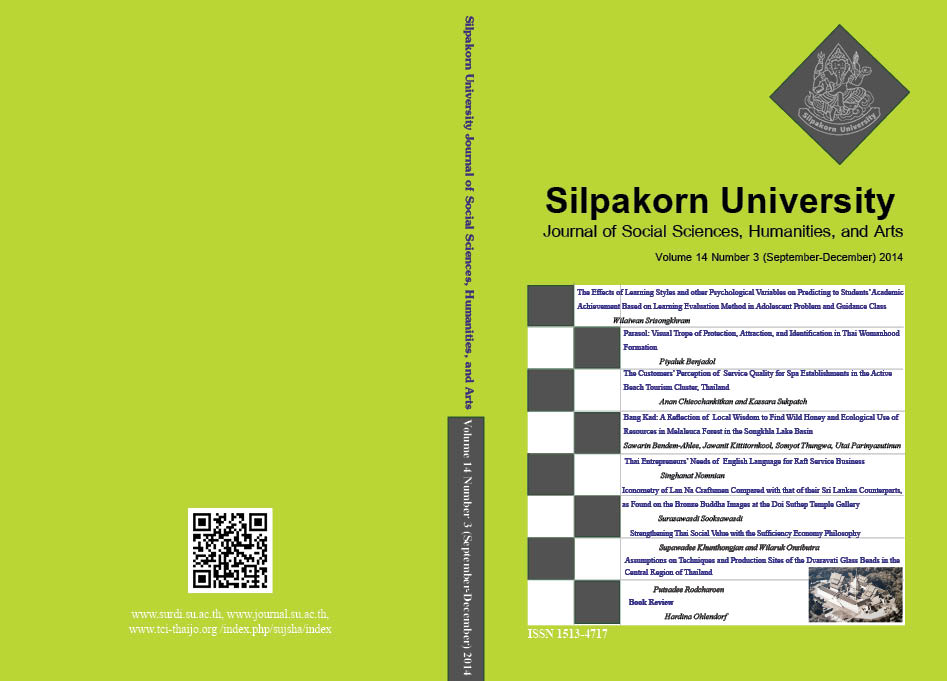Parasol: Visual Trope of Protection, Attraction, and Identification in Thai Womanhood Formation
Main Article Content
Abstract
In this research, eight visual representations of women holding parasols in Thai pre-school alphabet primers dating from between 1922 and 1977 are thoroughly analyzed, as the main resources, in order to reveal connotative meanings and their relations to Thai femininity discourses. Visual rhetoric, social semiotics, and multimodal critical discourse analysis frameworks are used as analytical tools. Besides functioning as a protective device against rain or sunlight, the parasol has long been connected to cultural and social ideologies, especially those referencing femininity. Through extensively analyzing paradigmatic and syntagmatic relations of visual features chosen to represent women holding a parasol in Thai alphabet primers, implicit meaning potentials about protection, attraction, and identification are found. Consequently, the power relations among participants involved under patriarchy are disclosed. As secondary resources, other media with images of
women holding parasols, such as magazine advertisements, book covers, newspaper covers, collectible cards, movie posters, and news photographs are contextually investigated as well. The discovered pattern and network of a “parasol” visual trope in various social practices reveals how these femininity discourses are repeatedly and perpetually disseminated in Thai society.
Downloads
Article Details
All rights reserved. Apart from citations for the purposes of research, private study, or criticism and review,no part of this publication may be reproduced, stored or transmitted in any other form without prior written permission by the publisher.
References
Benjadol, P. (2013) Visual Rhetoric of the Construction of Beauty in Thai Alphabet Primer, Yaw Ying. Paper presented at the Conference on Consilience and Innovation in Design, Tokyo, Japan August 26-30. accessed on December 3, 2013, https://design-cu.jp/iasdr2013/papers/1184-2b.pdf.
Hodge, R. and Kress, G. (1988) Social Semiotics. Cambridge: Polity.
Leeuwen, T. (2005) Introducing Social Semiotics. New York: Routledge.
Machin, D. and Mayr, A. (2012) How To Do Critical Discourse Analysis: A Multimodal Introduction. London: Sage Publications.
Nawigamune, A. (1993) Gae Roy Gaw Gai (Tracing Gaw Gai Alphabet). Bangkok: Sarakhadee.
Nawigamune, A. (2006) Pabtai Lae Singpim (Photographs and Publications). Bangkok: Matichon.
Nawigamune, A. (2007) Thai Advertisements Vol. 2 1920s. Bangkok: Saitharn.
Sukkawong, D. and Suwannapuk, S. (2002) Roy Pee Nhang Thai (A Century of Thai Cinema). Bangkok: River Books.
Sutthisakorn, O. (1990) Dok Mai Khong Chart: Jak Vethee Kwamngam Soo Vethee Cheevit. (Flowers of Nation: From Beauty Pageant Platform to the Platform of Life). Bangkok: Ruamthat.
Miss Thailand 1964 Miss Universe 1965 Photo Album. Bangkok: Krungthon Publisher.
(1971) Miss Thailand 2514 Photo Album. Bangkok: Sakulthai.
(1996) Tumnan Cheevit Kumpol Watcharapol (Chronocle of Kumpol Watcharapol’s Life). Bangkok: Thairath.


